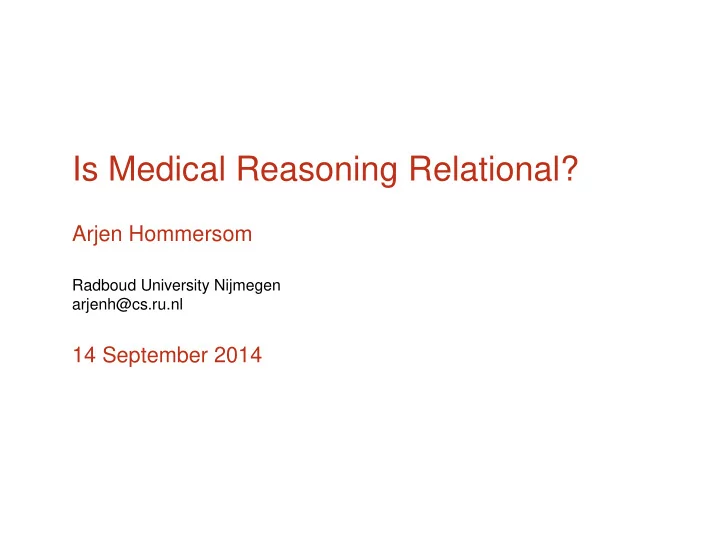

Is Medical Reasoning Relational? Arjen Hommersom Radboud University Nijmegen arjenh@cs.ru.nl 14 September 2014
Relational domains ◮ Relational: there are “general” rules describing the domain ◮ Example: physical sciences → broad class of generalisations described in a few axioms (e.g. F = ma for any force F ) ◮ In this presentation: suitable for representation in first-order (probabilistic) logical languages ◮ There are objects that are similar to other objects ◮ They play a ‘similar’ role in a model of the domain P ( cancer ( X )) = 0 . 01 , for all persons X ◮ Various new probabilistic techniques that exploit this!
Medicine ◮ Medicine: most domains cannot be described using a small number of axioms ◮ According to medical philosophy: usually overlapping interlevel temporal models (Schaffner, 1986) ◮ e.g. causal/deterministic relationships ◮ involving different levels (anatomy, physiology, etc) ◮ “relatively narrow scope of straightforward application” ◮ So just (propositional) Bayesian networks? ◮ But: “bear similarity resemblences to each other”
Research question ◮ Relational methods have useful applications in biomedicine ◮ Interpreting mammograms ◮ Biological networks ◮ Ontologies ◮ How useful are relational methods for the typical “medical temporal models”? ◮ Investigation on six “large” medical Bayesian networks ◮ ALARM, HEPAR2, PATHFINDER, DIABETES, LINK, and MUNIN ◮ None of these networks were designed for relational purposes
Methodology Factor graph representation of a BN (Niepert, 2012) S ⊤ f 2 S ⊥ S P ( s ) = 0 . 5 . 5 . 5 . 05 . 95 . 95 . 05 P ( c | s ) = 0 . 95 C ⊤ f 2 C ⊥ C P ( c | ¬ s ) = 0 . 05 (b) Associated factor graph (a) BN model Improvement = 1 − | Eq-classes | | Vars |
Graph colouring ◮ Graph colouring to find equivalence classes: ◮ Initially, all variables have the same colour ◮ Iterate until convergence: two vertices that so far have the same colour get different colours if for some colour c they have a different number of neighbours of colour c ◮ Different settings, initially, 1. factors have the same colour iff they represent the same function (equivalence class ≃ “symmetry”) 2. all factors have the same colour (equivalence class ≃ “structural symmetry”) 3. clustering of factors according to a similarity measure ( not shown here ) ◮ Can be computed efficiently (Kersting et al., AAAI’14) ◮ Applied to lifted belief propagation
Networks name #nodes #arcs #parameters #variables in factor graph ALARM 37 46 509 105 HEPAR2 70 1236 1453 162 PATHFINDER 135 200 77155 520 DIABETES 413 602 429409 4682 LINK 724 1125 14211 1833 MUNIN 1041 1397 80592 5651 ◮ Six medical networks > 30 nodes from Bayesian network repositories ◮ ALARM: monitoring network for assisting anesthesiologists ◮ HEPAR II: diagnosis of liver disease ◮ PATHFINDER: diagnosis of lymph node disease ◮ DIABETES: advising insulin dose adjustments ◮ LINK: pedigree network concerning ‘long QT syndrome’ (rare heart disease) ◮ MUNIN: diagnosis of neuromuscular disorders
Summary of main results ALARM Improv ement (%) = 1−(|Eq classes|/|Var|) 80 HEPAR2 PATHFINDER DIABETES LINK 60 MUNIN 40 20 0 Original network Factors assumed to be equal Networks
Conclusions ◮ Evidence for symmetries in large Bayesian networks (LINK, MUNIN) ◮ For example: in MUNIN this has to do with symmetry in the human body, e.g. ulnar nerve on the left and right hand side ◮ Also: in all networks there is a lot of symmetry in the structure ◮ Though we considered only one kind of symmetry ◮ Possible applications ◮ More understandable representations ◮ Lifted inference (asymmetric weighted model counting?) ◮ Relational learning
Recommend
More recommend